Ratiometric pH Sensing and Imaging in Living Cells with Dual-Emission Semiconductor Polymer Dots
Abstract
:1. Introduction
2. Results and Discussion
2.1. Design of Ratiometric pH Sensor Pdots-PF
2.2. Design of Ratiometric pH Sensor Pdots-PPF
2.3. Ratiometric Fluorescence Detection of pH in Buffer Solution
2.4. Reversibility, Stability, and Selectivity of the pH Sensors
2.5. Cell Imaging Applications of Pdots-PPF
3. Experimental Section
3.1. Materials and Reagents
3.2. Instruments
3.3. Preparation of Pdots-PF, Pdots-PP, and Pdots-PPF
3.4. Procedures for pH Detection
3.5. Cell Culture and Cell Imaging of Pdots
3.6. Cytotoxicity Assay
4. Conclusions
Author Contributions
Funding
Conflicts of Interest
References
- Shi, W.; Li, X.; Ma, H. A tunable ratiometric pH sensor based on carbon nanodots for the quantitative measurement of the intracellular pH of whole cells. Angew. Chem. Int. Ed. 2012, 51, 6432–6435. [Google Scholar] [CrossRef] [PubMed]
- Näreoja, T.; Deguchi, T.; Christ, S.; Peltomaa, R.; Prabhakar, N.; Fazeli, E.; Perälä, N.; Rosenholm, J.M.; Arppe, R.; Soukka, T. Ratiometric sensing and imaging of intracellular pH using polyethylenimine-coated photon upconversion nanoprobes. Anal. Chem. 2017, 89, 1501–1508. [Google Scholar] [CrossRef] [PubMed]
- Consolati, T.; Bolivar, J.M.; Petrasek, Z.; Berenguer, J.; Hidalgo, A.; Guisaán, J.M.; Nidetzky, B. Biobased, Internally pH-Sensitive Materials: Immobilized Yellow Fluorescent Protein as an Optical Sensor for Spatiotemporal Mapping of pH Inside Porous Matrices. ACS Appl. Mater. Interfaces 2018, 10, 6858–6868. [Google Scholar]
- Ratanaporncharoen, C.; Tabata, M.; Kitasako, Y.; Ikeda, M.; Goda, T.; Matsumoto, A.; Tagami, J.; Miyahara, Y. pH Mapping on Tooth Surfaces for Quantitative Caries Diagnosis Using Micro Ir/IrOx pH Sensor. Anal. Chem. 2018, 90, 4925–4931. [Google Scholar] [CrossRef] [PubMed]
- Zheng, Y.-B.; Zhao, S.; Cao, S.-H.; Cai, S.-L.; Cai, X.-H.; Li, Y.-Q. A temperature, pH and sugar triple-stimuli-responsive nanofluidic diode. Nanoscale 2017, 9, 433–439. [Google Scholar] [CrossRef] [PubMed]
- Zhao, S.; Lan, M.; Zhu, X.; Xue, H.; Ng, T.-W.; Meng, X.; Lee, C.-S.; Wang, P.; Zhang, W. Green synthesis of bifunctional fluorescent carbon dots from garlic for cellular imaging and free radical scavenging. ACS Appl. Mater. Interfaces 2015, 7, 17054–17060. [Google Scholar] [CrossRef] [PubMed]
- Li, S.; Chang, K.; Sun, K.; Tang, Y.; Cui, N.; Wang, Y.; Qin, W.; Xu, H.; Wu, C. Amplified singlet oxygen generation in semiconductor polymer dots for photodynamic cancer therapy. ACS Appl. Mater. Interfaces 2015, 8, 3624–3634. [Google Scholar]
- Zhong, D.; Miao, H.; Yang, K.; Yang, X. Carbon dots originated from carnation for fluorescent and colorimetric pH sensing. Mater. Lett. 2016, 166, 89–92. [Google Scholar] [CrossRef]
- Hou, Y.; Zhou, J.; Gao, Z.; Sun, X.; Liu, C.; Shangguan, D.; Yang, W.; Gao, M. Protease-activated ratiometric fluorescent probe for pH mapping of malignant tumors. ACS Nano 2015, 9, 3199–3205. [Google Scholar] [CrossRef]
- Bai, Z.; Chen, R.; Si, P.; Huang, Y.; Sun, H.; Kim, D.-H. Fluorescent pH sensor based on Ag@ SiO2 core–shell nanoparticle. ACS Appl. Mater. Interfaces 2013, 5, 5856–5860. [Google Scholar] [CrossRef]
- Hong, S.W.; Jo, W.H. A fluorescence resonance energy transfer probe for sensing pH in aqueous solution. Polymer 2008, 49, 4180–4187. [Google Scholar] [CrossRef]
- Rasheed, H.S.; Ahmed, N.M.; Matjafri, M. Ag metal mid layer based on new sensing multilayers structure extended gate field effect transistor (EG-FET) for pH sensor. Mater. Sci. Semicond. Process. 2018, 74, 51–56. [Google Scholar] [CrossRef]
- Ang, P.K.; Chen, W.; Wee, A.T.S.; Loh, K.P. Solution-gated epitaxial graphene as pH sensor. J. Am. Chem. Soc. 2008, 130, 14392–14393. [Google Scholar] [CrossRef] [PubMed]
- Cui, D.; Xie, C.; Pu, K. Development of semiconducting polymer nanoparticles for photoacoustic imaging. Macromol. Rapid Commun. 2017, 38, 1700125. [Google Scholar] [CrossRef] [PubMed]
- Guo, L.; Ge, J.; Wang, P. Polymer dots as effective phototheranostic agents. Photochem. Photobiol. 2018, 94, 916–934. [Google Scholar] [CrossRef] [PubMed]
- Wu, C.; Chiu, D.T. Highly fluorescent semiconducting polymer dots for biology and medicine. Angew. Chem. (Int. Ed. English) 2013, 52, 3086–3109. [Google Scholar] [CrossRef] [PubMed]
- Liu, X.; Wang, T.; Wang, W.; Zhou, Z.; Yan, Y. A tailored molecular imprinting ratiometric fluorescent sensor based on red/blue carbon dots for ultrasensitive tetracycline detection. J. Ind. Eng. Chem. 2019, 72, 100–106. [Google Scholar] [CrossRef]
- Wang, X.; Yu, S.; Liu, W.; Fu, L.; Wang, Y.; Li, J.; Chen, L. Molecular imprinting based hybrid ratiometric fluorescence sensor for the visual determination of bovine hemoglobin. ACS Sensors 2018, 3, 378–385. [Google Scholar] [CrossRef]
- Jin, T.; Sasaki, A.; Kinjo, M.; Miyazaki, J. A quantum dot-based ratiometric pH sensor. Chem. Commun. 2010, 46, 2408–2410. [Google Scholar] [CrossRef]
- Li, Y.; Wang, Y.; Yang, S.; Zhao, Y.; Yuan, L.; Zheng, J.; Yang, R. Hemicyanine-based high resolution ratiometric near-infrared fluorescent probe for monitoring pH changes in vivo. Anal. Chem. 2015, 87, 2495–2503. [Google Scholar] [CrossRef]
- Sun, J.; Ling, P.; Gao, F. A Mitochondria-Targeted Ratiometric Biosensor for pH Monitoring and Imaging in Living Cells with Congo-Red-Functionalized Dual-Emission Semiconducting Polymer Dots. Anal. Chem. 2017, 89, 11703–11710. [Google Scholar] [CrossRef]
- Chan, Y.-H.; Wu, C.; Ye, F.; Jin, Y.; Smith, P.B.; Chiu, D.T. Development of ultrabright semiconducting polymer dots for ratiometric pH sensing. Anal. Chem. 2011, 83, 1448–1455. [Google Scholar] [CrossRef] [PubMed]
- Ma, L.Y.; Wang, H.Y.; Xie, H.; Xu, L.X. A long lifetime chemical sensor: study on fluorescence property of fluorescein isothiocyanate and preparation of pH chemical sensor. Spectrochim. Acta. Part. A Mol. Biomol. Spectrosc. 2004, 60, 1865–1872. [Google Scholar] [CrossRef] [PubMed]
Sample Availability: Samples of the compounds in this article are not available from the authors. |
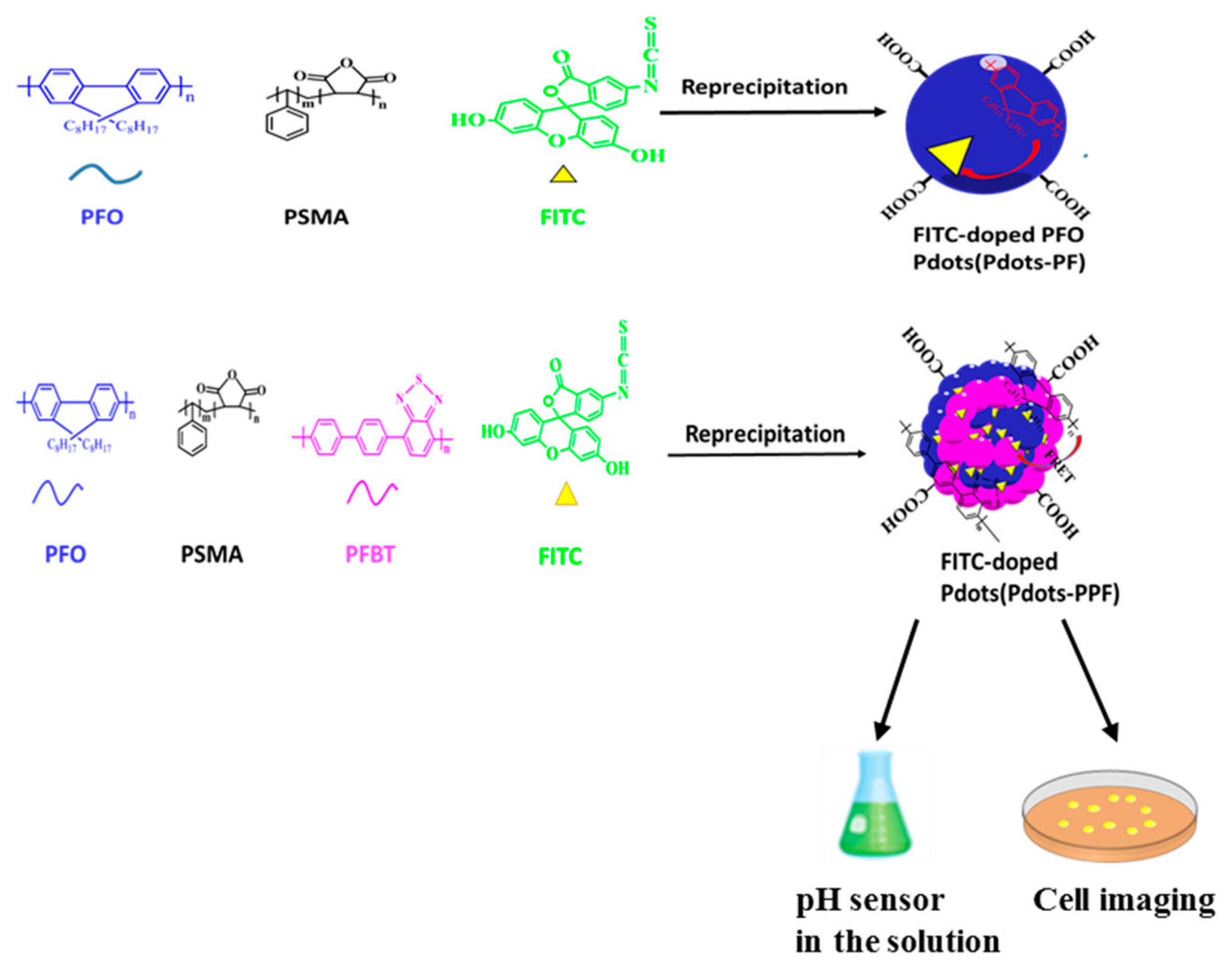
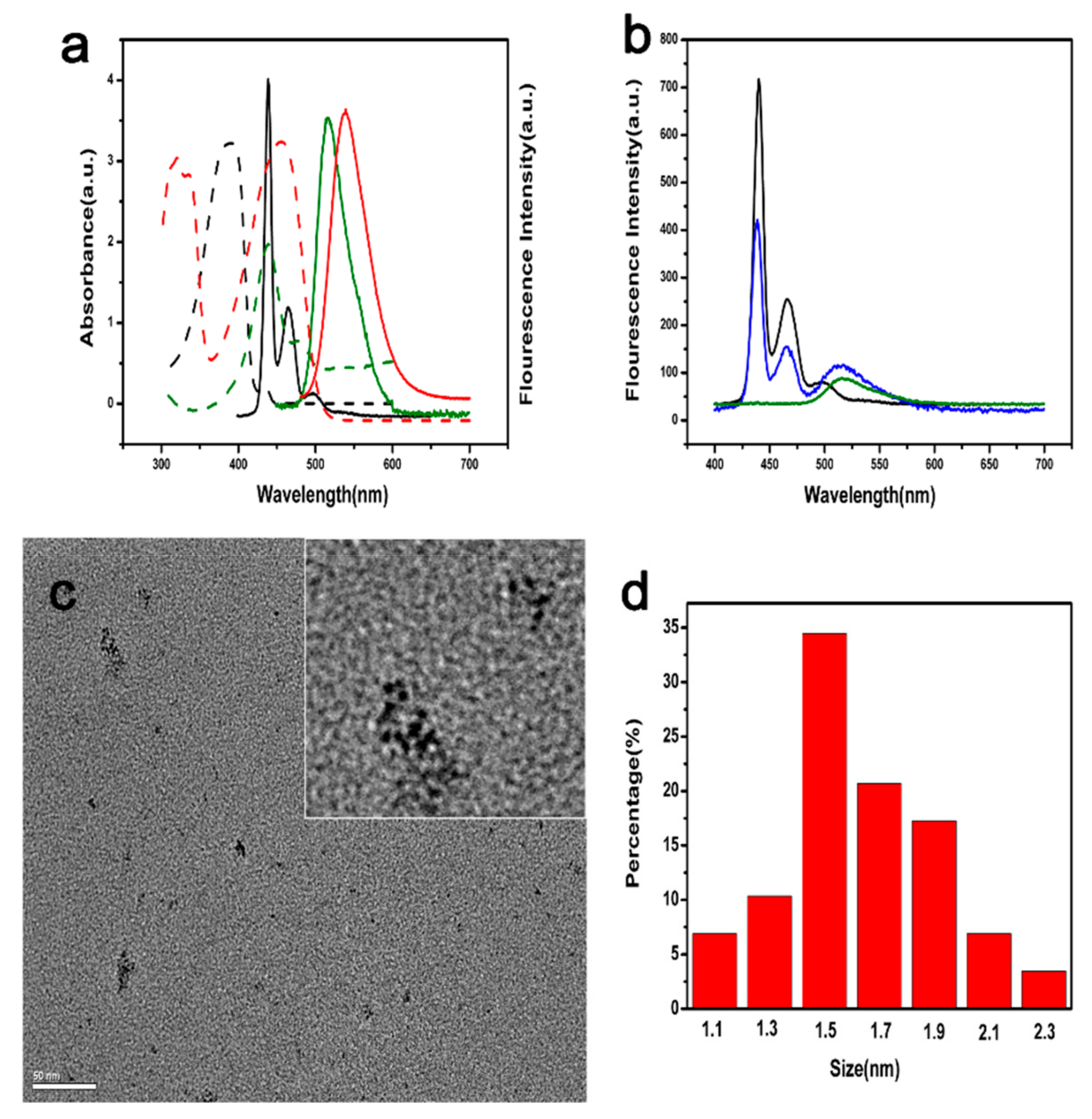
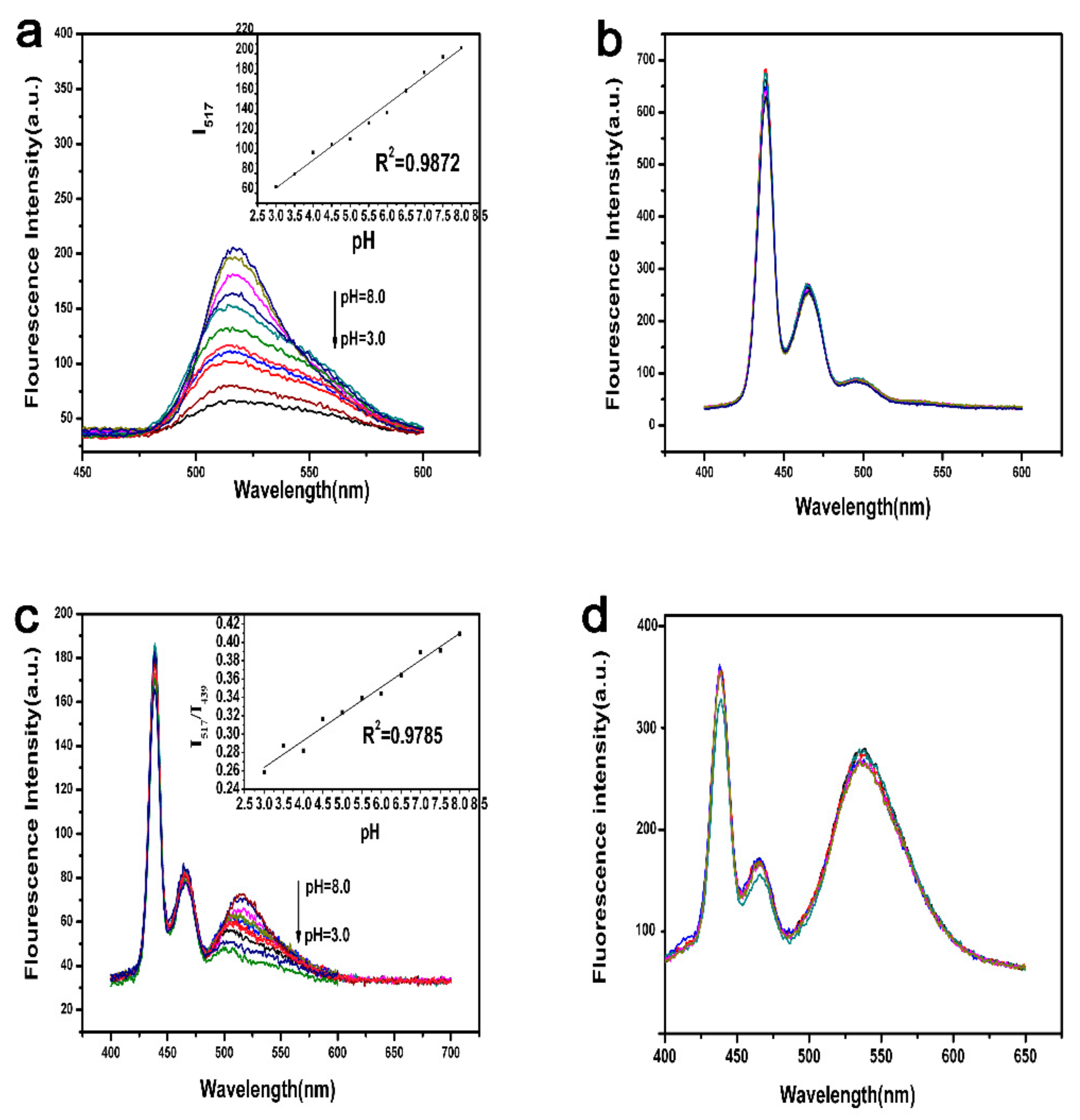

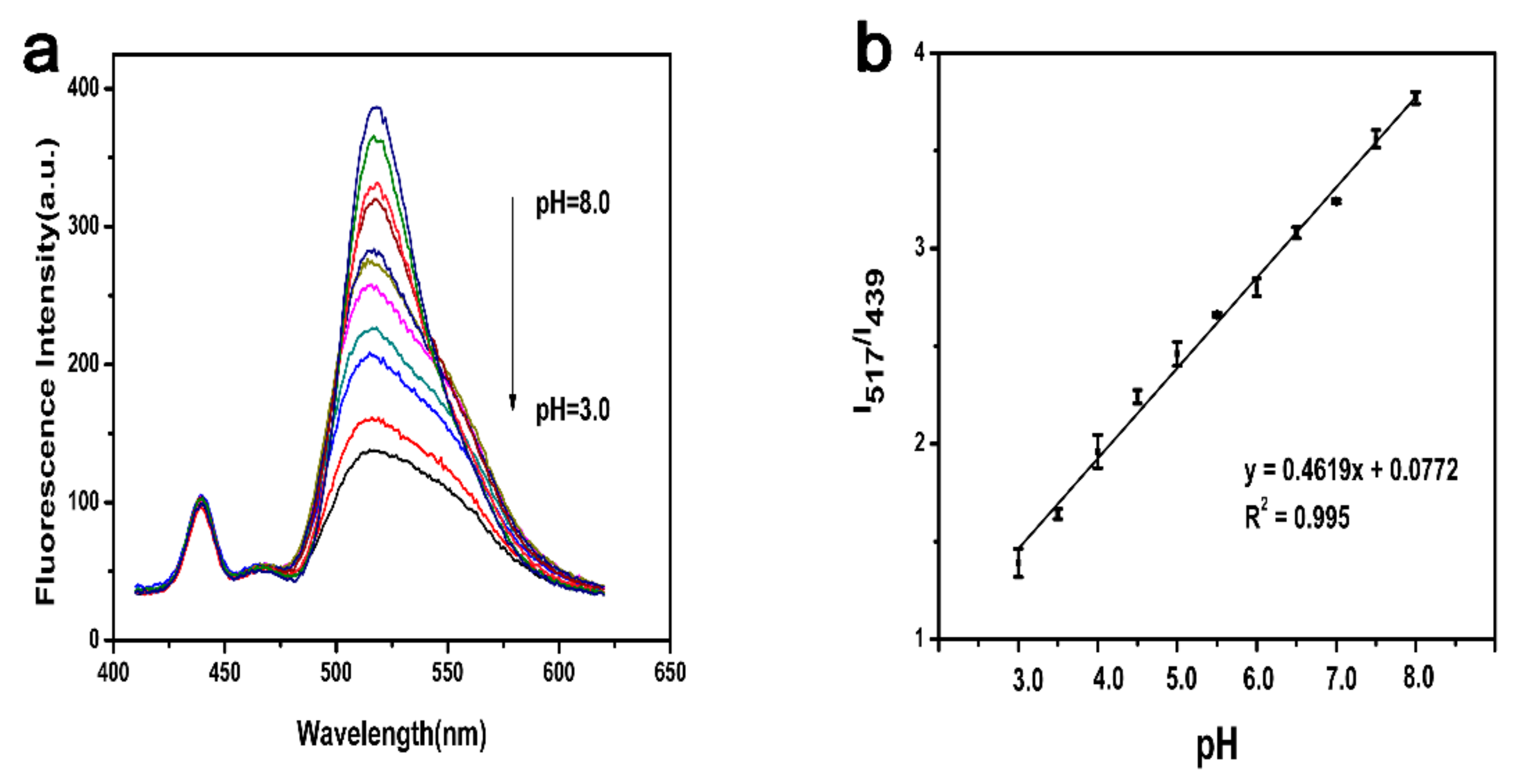
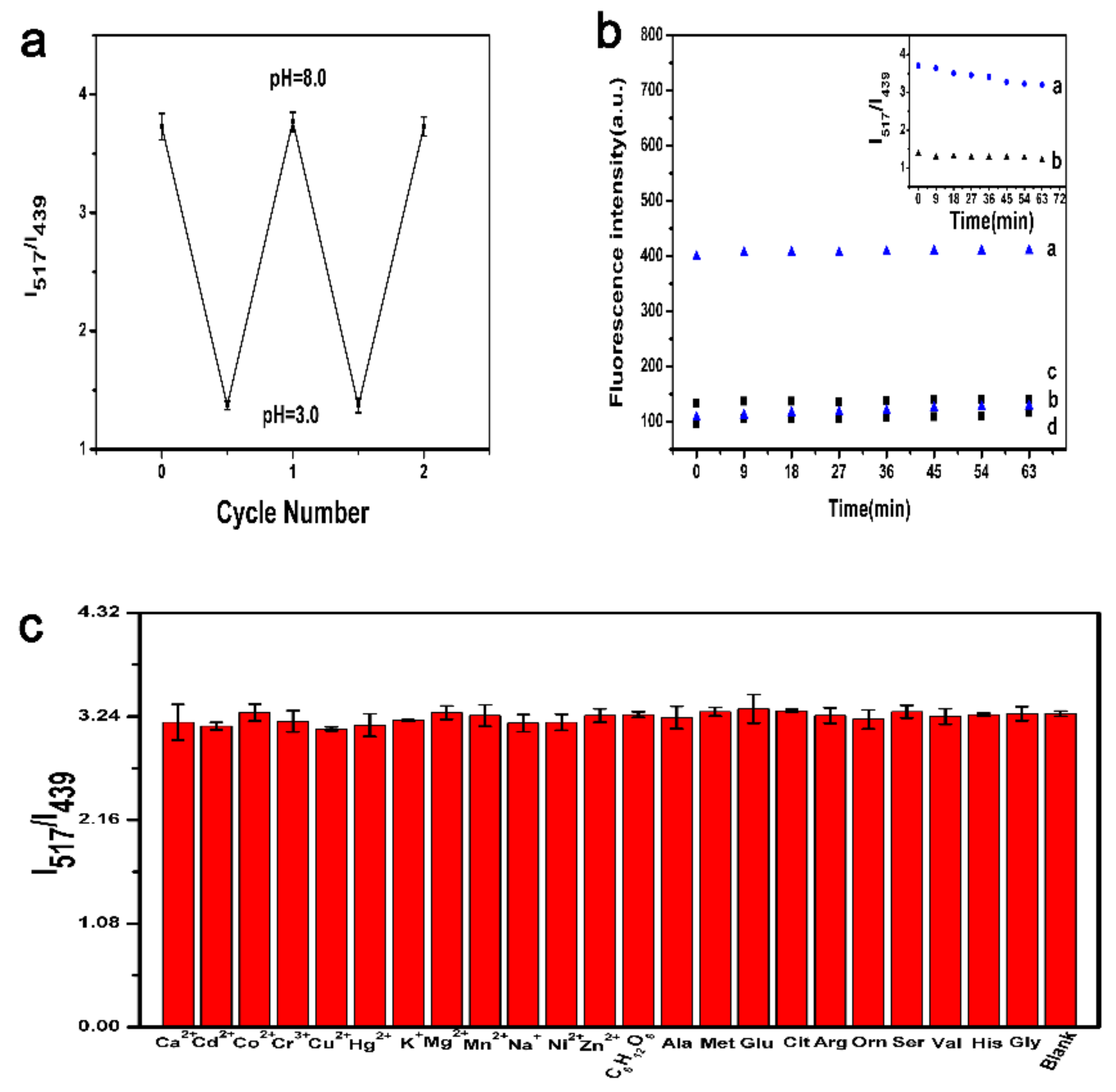
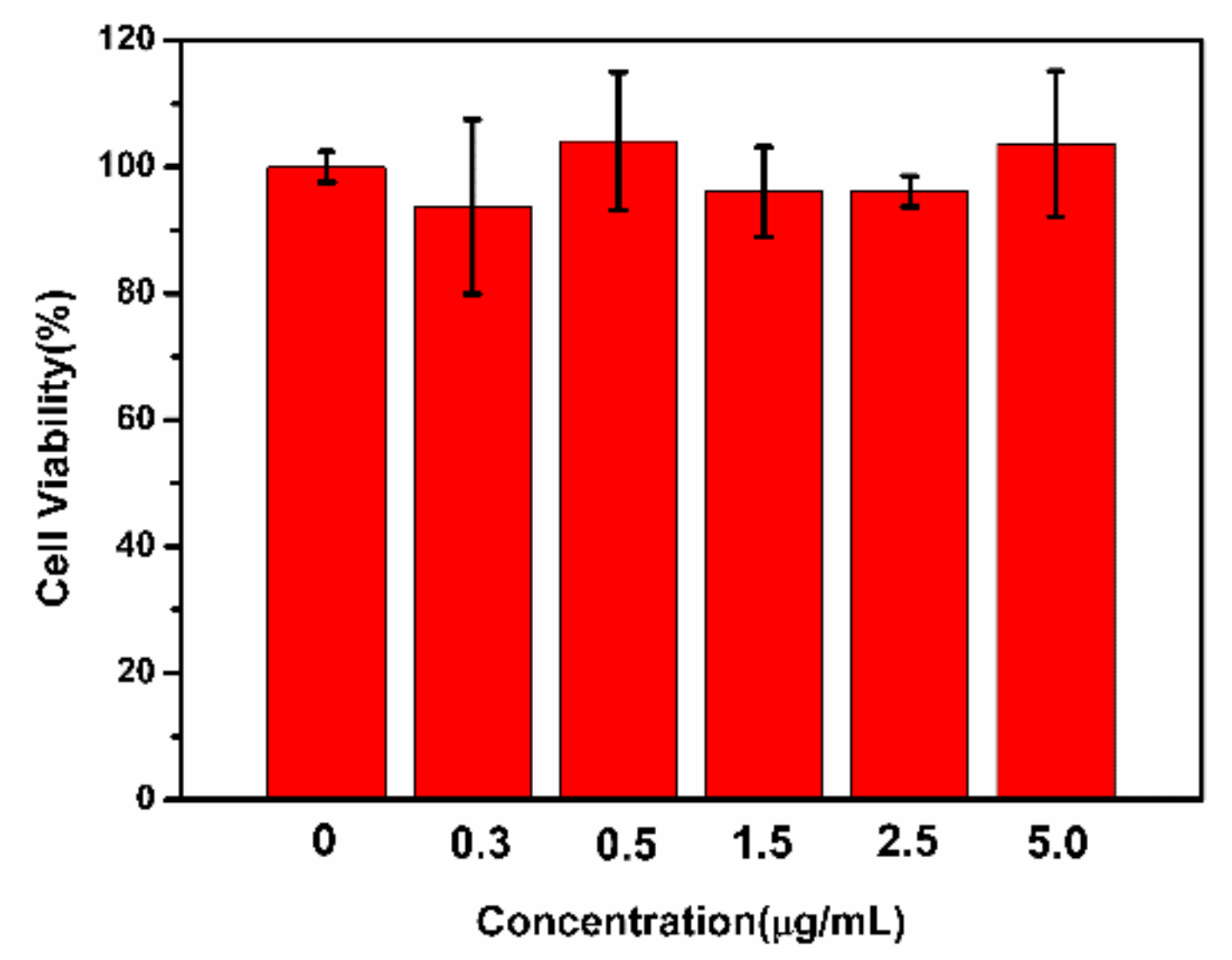
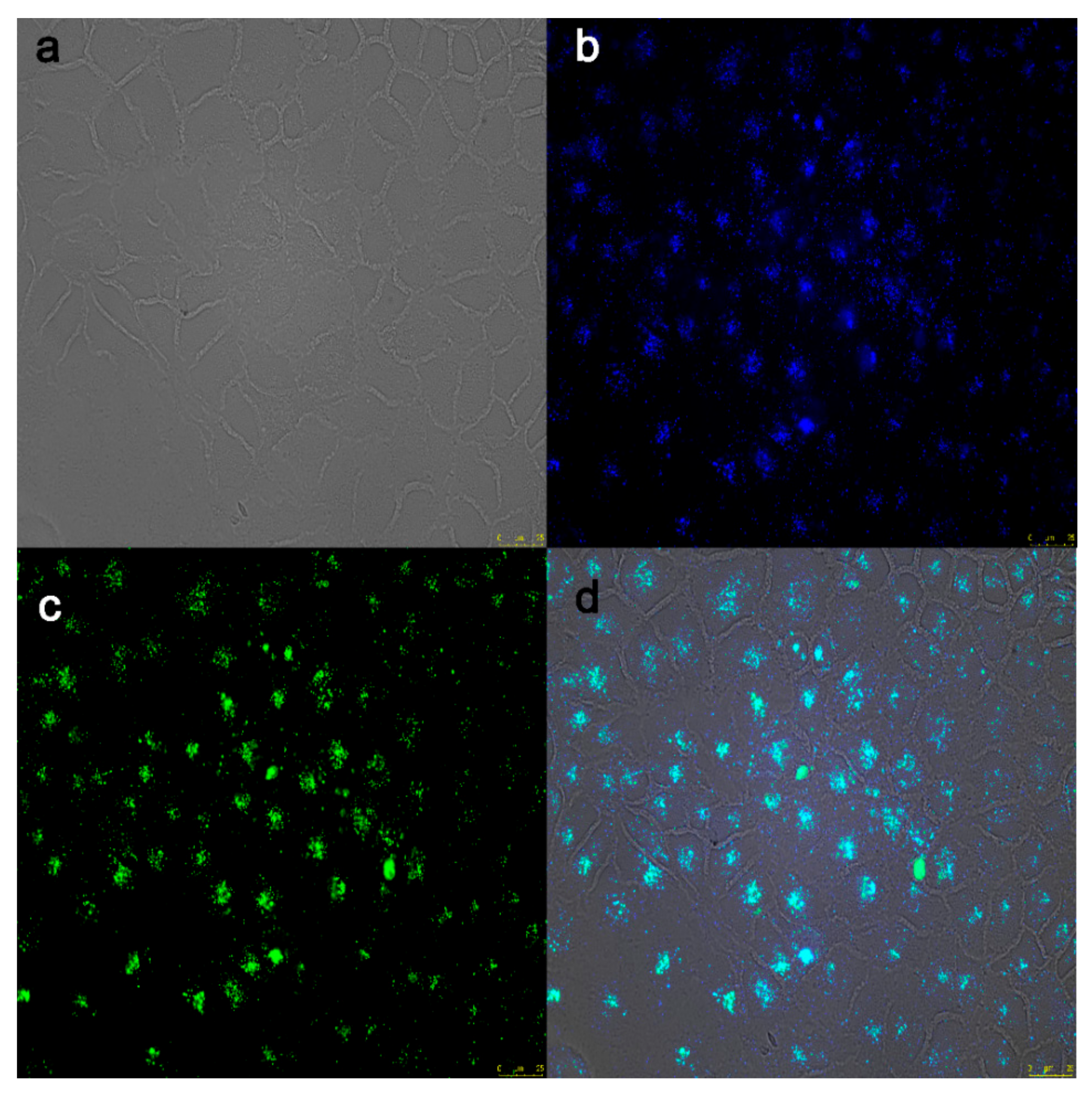
| Components | Functions |
|---|---|
| PFO | FRET donor, provide reference signal (I439) |
| PFBT | FRET acceptor, FITC signal amplifier |
| FITC | FRET acceptor, provide pH-responsive signal (I517) |
| PMSA | Cross-linking |
| pH Sensors | Components | FRET | Emission | pH Sensitivity |
|---|---|---|---|---|
| FITC | FITC | No | Single | Robust |
| PFO Pdots | PFO, PMSA | No | Single | No |
| Pdots-PF | PFO, FITC, PMSA | PFO to FITC | Dual | Weak |
| Pdots-PP | PFO, PFBT, PMSA | PFO to PFBT | Dual | No |
| Pdots-PPF | PFO, PFBT, FITC, PMSA | PFO to FITC/PFBT | Dual | Robust |
© 2019 by the authors. Licensee MDPI, Basel, Switzerland. This article is an open access article distributed under the terms and conditions of the Creative Commons Attribution (CC BY) license (http://creativecommons.org/licenses/by/4.0/).
Share and Cite
Chen, P.; Ilyas, I.; He, S.; Xing, Y.; Jin, Z.; Huang, C. Ratiometric pH Sensing and Imaging in Living Cells with Dual-Emission Semiconductor Polymer Dots. Molecules 2019, 24, 2923. https://doi.org/10.3390/molecules24162923
Chen P, Ilyas I, He S, Xing Y, Jin Z, Huang C. Ratiometric pH Sensing and Imaging in Living Cells with Dual-Emission Semiconductor Polymer Dots. Molecules. 2019; 24(16):2923. https://doi.org/10.3390/molecules24162923
Chicago/Turabian StyleChen, Piaopiao, Iqra Ilyas, Su He, Yichen Xing, Zhigang Jin, and Chaobiao Huang. 2019. "Ratiometric pH Sensing and Imaging in Living Cells with Dual-Emission Semiconductor Polymer Dots" Molecules 24, no. 16: 2923. https://doi.org/10.3390/molecules24162923
APA StyleChen, P., Ilyas, I., He, S., Xing, Y., Jin, Z., & Huang, C. (2019). Ratiometric pH Sensing and Imaging in Living Cells with Dual-Emission Semiconductor Polymer Dots. Molecules, 24(16), 2923. https://doi.org/10.3390/molecules24162923





